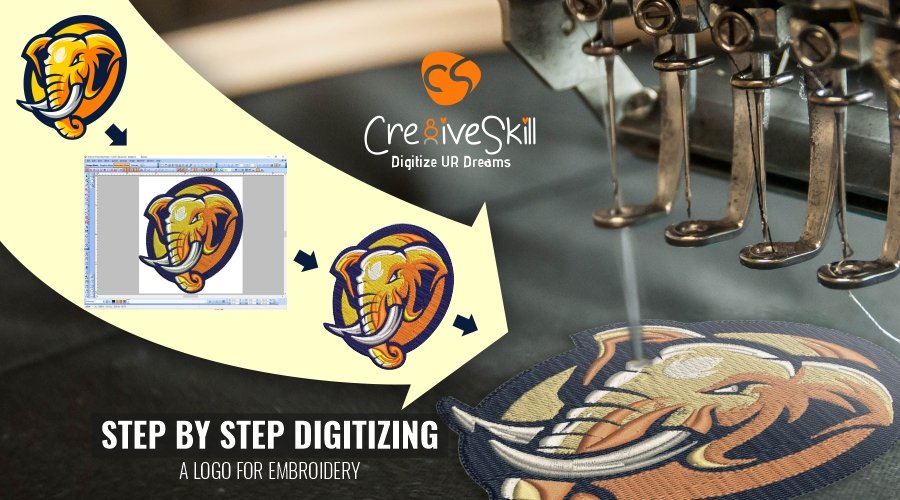Streamlining the Art of Embroidery Digitizing: Step-by-Step Overview
Needlework digitizing is a thorough craft that demands precision and imagination. As technology continues to advance, the digitization procedure has actually become much more accessible, enabling fanatics to bring their detailed layouts to life with ease. In this overview, we will certainly unravel the complexities of needlework digitizing, breaking down each action systematically to streamline the procedure and equip both beginners and seasoned embroiderers alike. Keep tuned to discover exactly how you can streamline this detailed art type and transform your imaginative visions into perfectly embroidered masterpieces.
Comprehending Embroidery Digitizing Software Application
Embroidery digitizing software program offers as an important device for changing elaborate designs right into digital formats compatible with needlework equipments, assisting in accurate sewing and personalization. This specialized software program allows users to import numerous photo data formats, such as JPG or PNG, and convert them right into needlework machine-readable styles like DST, EXP, or PES - Digitizing for Embroidery. By utilizing features like stitch editing, underlay options, and string color choice, digitizing software program makes it possible for individuals to manage every element of the layout procedure
Additionally, progressed needlework digitizing software application supplies tools for producing complicated designs, readjusting stitch thickness, and incorporating complex information. Customers can additionally preview the style prior to stitching it out, ensuring accuracy and decreasing errors. In addition, several software application give automatic attributes that aid streamline the digitizing procedure, conserving effort and time.
Understanding the abilities of embroidery digitizing software program is important for achieving top quality lead to embroidery jobs. By mastering this device, needlework enthusiasts and specialists can release their creative thinking and bring elaborate layouts to life with accuracy and efficiency.

Picking the Right Style Data
After acquainting yourself with the abilities of needlework digitizing software program, the following important action in the procedure is picking the best layout file for your job. Digitizing for Embroidery. When choosing a layout file for embroidery digitizing, it's important to consider the complexity of the style, the size of the end product, and the kind of fabric you will be dealing with
For detailed styles with fine details, a high-resolution image or vector data is suggested to make sure that the needlework machine can properly replicate the design. Furthermore, the dimension of the end product plays a significant function in selecting the ideal style data. Larger styles might need higher resolution data to maintain clearness and intensity.
Additionally, the kind of material you will be stitching on affects the option of layout file. Various materials might need adjustments in the layout data to make certain that the stitches are appropriately lined up and the style looks like meant. By very carefully selecting the appropriate design file based on these factors, you can establish yourself up for an use this link effective embroidery digitizing process.
Digitizing Devices and Methods
Utilizing specialized software program and precision strategies, digitizing devices are important in changing intricate layouts right into embroidery-ready files. Embroidery digitizing software, such as Wilcom, Hatch, or Embrilliance, provides the essential platform to transform artwork into stitch information. These programs supply features like stitch modifying, underlay choices, and lettering tools to make sure the layout equates perfectly onto material.
Among the crucial techniques in digitizing is creating a clear path for the needlework machine to adhere to. This entails digitizing each element of the layout with precision, figuring out stitch types, densities, and directions. By utilizing tools like digitizing tablets or software-specific plugins, embroiderers can accomplish a high degree of accuracy in their digitized designs.
Furthermore, mastering the art of rug stitching is important for generating high quality needlework. Underlay sewing stabilizes the textile and creates a foundation for the design, guaranteeing that the last product is both visually appealing and resilient. By recognizing these digitizing tools and methods, embroiderers can raise their craft and bring elaborate layouts to life with precision and performance.
Tailoring Stitch Types and Instructions
The selection of stitch kinds can considerably impact the general appearance and structure of the stitched style. By purposefully combining these stitch kinds, embroiderers can attain deepness and dimension in their designs.
Additionally, the direction of stitches plays an essential function in improving the visual charm of the final embroidery. By trying out with different stitch angles and patterns, embroiderers can bring their designs to life with amazing detail and intricacy.
Testing and Refining Your Digitized Style
To ensure the accuracy and quality of your digitized layout, complete screening and improvement are vital steps in the needlework digitizing process. As soon as you have actually finished the digitization of your style, it is vital to examine it prior to continuing with the actual embroidery. Evaluating allows you to identify any kind of possible concerns such as string breaks, sew thickness troubles, or layout distortions that may affect the outcome.

After testing, it is necessary to refine your digitized style based upon the responses from the examination sew-out. click here for more info This might include tweaking sew settings, readjusting densities, or making modifications to the general style to achieve the wanted end result. By repeating with testing and improvement, you can fine-tune your digitized style to perfection before progressing with the real embroidery process.
Verdict
In conclusion, understanding the art of needlework digitizing calls for an extensive understanding of the software application, picking the appropriate style file, using digitizing tools and strategies, tailoring stitch types and instructions, and testing and refining the digitized design. By adhering to these steps, embroiderers can simplify the digitizing procedure and produce top quality stitched styles with precision and see performance.